
 The second generation (in N. America) of Sikh organizations are beginning to pool their resources and expand their capabilities. Here I feature 2.
The second generation (in N. America) of Sikh organizations are beginning to pool their resources and expand their capabilities. Here I feature 2.
Seva Food Bank – earlier this summer, Seva Food Bank of Canada welcomed Michael Brito as their part-time Operations Manager. We look forward to hearing about the meaning of the expansion and the exciting growth this service Sikh-based organization is undergoing.
ENSAAF – One of the premier human rights organizations working on issues related to the Sikhs is hiring a Case Summary Writer to draft case summaries based on interviews of families whose loved ones were unlawfully killed or disappeared by India’s security forces. The job description reads:
As the case summaries will ultimately be used in a variety of advocacy initiatives and reports, this is an important position that will offer someone a chance to help mobilize international stakeholders on the issue of impunity for mass state crimes in Punjab, India.
We hope a number of Sikhs decide to apply and promote the goals of this extremely important cause. You can get more information on the ENSAAF website, here. Please read the job description and apply! If not, at least circulate, forward, post on Facebook, tweet on Twitter, and get out the word!
This Monday, Sikhs for Justice is organizing a rally at the United Nations Headquarters to call for UN intervention stop India’s planned execution of Professor Devenderpal Singh Bhullar. Professor Bhullar’s brother, Tejinder Singh Bhullar will be addressing the rally. In their appeal to Secretary General Ban Ki moon, Sikhs for Justice is calling upon the U.N. to intervene and free Professor Bhullar based on a UN General Assembly resolution adopted in 2008 known as Resolution 62/149 which called on all major states to abolish the death penalty. 62/149 is a nonbinding instrument to mark progress on the United Nation’s position that they death penalty undermines human dignity and acknowledges the serious claim that any failure of justice in the implementation of the death penalty is irreversible and irreplaceable.
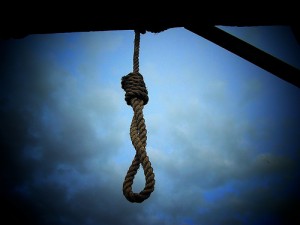 The death penalty too, runs contrary to Sikh historical positions on capital punishment. The Sarkar-e-Khalsa of Maharaja Ranjit Singh Ji, followed a no death penalty policy, as M. Gregor in his 1846 ‘History of the Sikhs’ writes. He notes that, ‘[Ranjit Singh] was the exception of Oriental monarchs, and never wantonly inflicted capital punishment and mutilation.’ Other authors describe, that ‘Humanity indeed, or rather a tenderness for life, was a trait in the character of Ranjit Singh. There is no instances of him having wantonly imbued his hands in blood.’ These sentiments that can be seen as consistent Sikh political philosophy captured by the Zafarnama and other documents. Specifically in the Zafarnama, Guru Gobind Singh Ji quotes the Persian poet Firdausi, writing, ‘How nicely the sweet tongued poet Firdausi has said, to act in haste is the work of the devil,’ referring to Aurungzeb’s executions of the youngest Sahibzadas Zorawar and Fateh Singh and Mata Gujri in Sirhind as the act of ‘Sheitan.’
The death penalty too, runs contrary to Sikh historical positions on capital punishment. The Sarkar-e-Khalsa of Maharaja Ranjit Singh Ji, followed a no death penalty policy, as M. Gregor in his 1846 ‘History of the Sikhs’ writes. He notes that, ‘[Ranjit Singh] was the exception of Oriental monarchs, and never wantonly inflicted capital punishment and mutilation.’ Other authors describe, that ‘Humanity indeed, or rather a tenderness for life, was a trait in the character of Ranjit Singh. There is no instances of him having wantonly imbued his hands in blood.’ These sentiments that can be seen as consistent Sikh political philosophy captured by the Zafarnama and other documents. Specifically in the Zafarnama, Guru Gobind Singh Ji quotes the Persian poet Firdausi, writing, ‘How nicely the sweet tongued poet Firdausi has said, to act in haste is the work of the devil,’ referring to Aurungzeb’s executions of the youngest Sahibzadas Zorawar and Fateh Singh and Mata Gujri in Sirhind as the act of ‘Sheitan.’
I just got an email from the Working Families Party (a progressive political party in NYC) about the latest developments in mega-corporation Walmart’s latest attempts to set up shop in NYC. One of the biggest real estate development companies in the city called Related is reportedly in discussions with Walmart about building its first NYC store in the Brooklyn neighborhood of East New York. The below video put together by ALIGN, the Alliance for a Greater New York, features a Sikh business owner, Iqbal Chhabra.

This video warmed my heart for several reasons. It goes without saying that I live in Brooklyn and am concerned with all things Brooklyn. Brooklyn is not exactly known for its large Sikh population. I see the occasional Sikh construction worker or shop owner, but I don’t know of too many other Brooklynwale Singhs or Kaurs. So I was pleasantly surprised to see Mr. Chhabra speaking out about an important Brooklyn-based issue in this video.

Amritsar, 1946
I’m going to continue on what appears to be our theme of the week here at TLH — Sikhs and sports. I’m not much of an athlete, though I had a good run of Little League baseball when I was a kid in North Carolina. I remember how goofy I felt wearing my team’s baseball cap over my patka and of course a helmet when I was up to bat. Looking back at the photographs, I looked pretty goofy too.
Fast forward a couple of decades, and I find myself in a related dilemma, though hardly an aesthetic one. This time of year in New York City, my favorite (and most efficient) way to get around is on my bike (the kind that requires pedaling). It’s good exercise, it gets me around Brooklyn and other parts of the city often as quick or quicker than public transit, and it leaves no carbon footprint.
As a dastaar-wearing Sikh, I grapple every day with my decision to ride my bike without a helmet — especially in a place like New York City. I’ve had many friends try to convince me to do otherwise, and I’ve tried many experiments of trying to make a helmet work. After talking to many a bike shop employees, my understanding at the moment is that bike helmets and turbans can’t really co-exist effectively. Even if I were to get an extra large helmet and put it over a small dastaar, it would not protect my skull sufficiently because it would sit too high up.
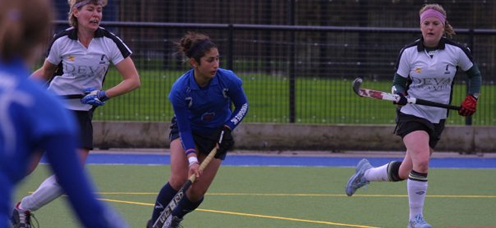
Ashpal Kaur Bhogal
TLH has covered several promising athletes in the Sikh community. Basketball player Darsh Singh, Football player Nuvraj Bassi, and Boxer Andrew Singh Kooner. The list of Sikh athletes is fortunately growing, including Fauja Singh, Pardeep Nagra, and Subaig Singh – some of whom we have covered and others we haven’t had a chance to. Jodha recently updated us on the Bhullar Brothers, potential NBA-ers, Sim Bhullar and younger brother Tanveer Bhullar, both 7-foot-somethings.
The thing about this list, however, is that all of these athletes are men.
It begs the question, then, where is the representation of Kaurs in sports today? After watching news coverage of the growing number of women playing kabaddi in Punjab, and with the popularity of the Women’s World Cup finals this past weekend, it made me think about the importance of sports in the lives of young Sikh girls. Much has been written about why sports are critical for young girls.
A large body of research shows that sports are associated with all sorts of benefits, like lower teenage pregnancy rates, better grades and higher self-esteem… separate studies from two economists offer some answers, providing the strongest evidence yet that team sports can result in lifelong improvements to educational, work and health prospects… Using a complex analysis, Dr. Stevenson showed that increasing girls’ sports participation had a direct effect on women’s education and employment. [link]
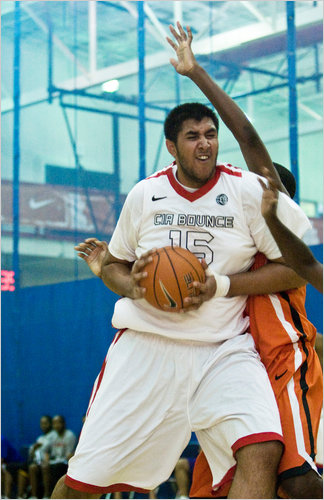 It wasn’t quite the Bhullar I was looking for when I was googling information last week, but it did warrant a revisit.
It wasn’t quite the Bhullar I was looking for when I was googling information last week, but it did warrant a revisit.
Some time ago I wrote an article about how I wish I was a lil bit taller, highlighting the Brother Bhullar – Sim and Tanveer.
Sim is in the press again. The 7’4” Brampton native is all set to join Xavier University in the fall. Until then, he had been helping Team Canada in the FIBA under-19 world championships in Latvia. Sim had a crushing performance against the South Koreans, dumping 24 points and grabbing 14 rebounds. Messed around and got a double-double.
In a New York Times article this week, featuring Sim, Heidi Ueberroth, the president of NBA International stated:
“Having a player from India in the N.B.A. is a question of when, not if. We have no doubt that the elite players from India will emerge.”
I would make a major correction and substitute Punjab for India.
Check out his highlight reel, before clicking below the fold.

Kudarat 2011 at Olympic National Park on July 21- 24
“Inspiration from Within: Unlocking Sikh Creativity”
 In my experience at conferences/retreats, or at youth camps there is a huge emphasis on sangat. What is it? Who are they? Or, how as an individual, we can make impact. In these discussions, I have intellectually understood sangat and, in some instances, would even go as far to say that I have experienced it.
In my experience at conferences/retreats, or at youth camps there is a huge emphasis on sangat. What is it? Who are they? Or, how as an individual, we can make impact. In these discussions, I have intellectually understood sangat and, in some instances, would even go as far to say that I have experienced it.
It is in this moment of EXPERIENCE that relationships develop. Whether with each other through the shared experience, with the Guru, with a feeling, or with an idea.
Tolsoy has explained “art” within a similar paradigm. “The activity of art is based on the fact that a man, receiving through his sense of hearing or sight another man’s expression of feeling, is capable of experiencing the emotion which moved the man who expressed it.”
Guest blogged by Neesha Meminger
Admin note: In an effort to further cultivate the conversation on Faith and Feminism within the Sikh community, panelists from the Open Heart/Closed Fist event in NYC will share their thoughts with us. To learn more about the panel, please read Sikh Women Speak Out on Faith and Feminism.
::
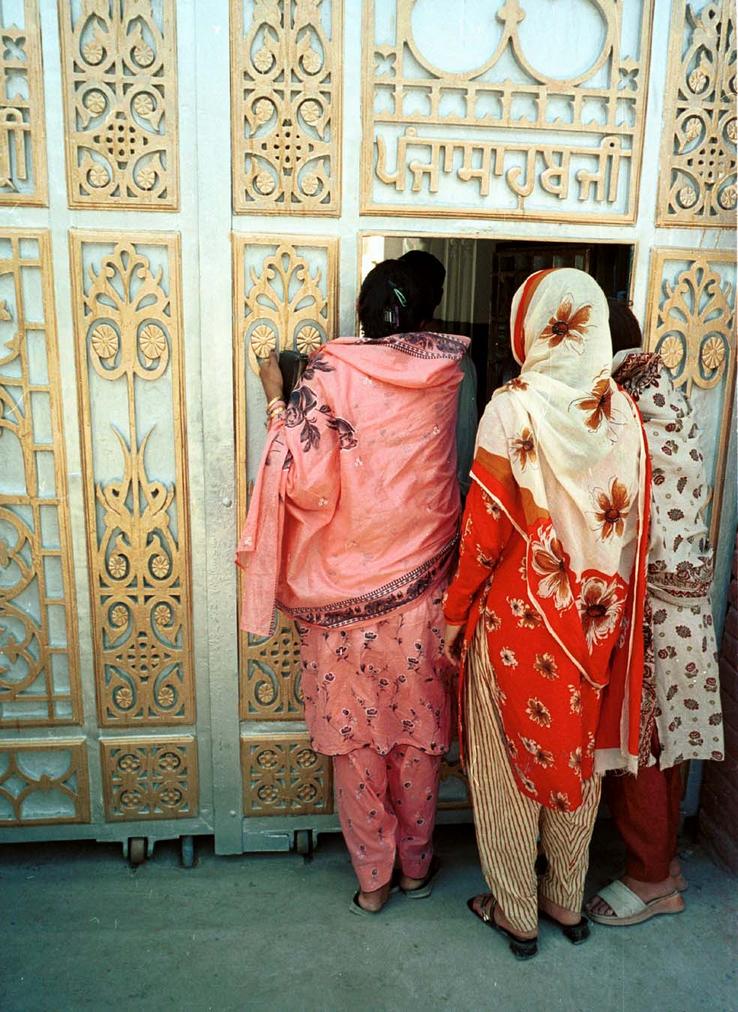 I walked away from our panel with mixed feelings. On the one hand – how exhilarating to sit in a room full of South Asian men and women and put a spotlight on the thoughts and experiences of Sikh women! I tried to remember when I ever sat in a room like that and spent two hours or more talking about what it means to be a Sikh woman and the importance of that in my life – never mind the validation by others I barely knew or had just met. The fact that this space was created at all was enough to leave me feeling full, and bursting with the need to create more such spaces and conversations.
I walked away from our panel with mixed feelings. On the one hand – how exhilarating to sit in a room full of South Asian men and women and put a spotlight on the thoughts and experiences of Sikh women! I tried to remember when I ever sat in a room like that and spent two hours or more talking about what it means to be a Sikh woman and the importance of that in my life – never mind the validation by others I barely knew or had just met. The fact that this space was created at all was enough to leave me feeling full, and bursting with the need to create more such spaces and conversations.
On the other hand, I realized, from some of the questions asked, that we are just at the beginnings of this dialogue. I have a lot of faith in our community, because I believe that out of all the other spaces in my life, this is where an honest conversation can take place; one that not only encompasses politics and radical discourse, but spirituality, as well. For if not here, where?
Sikhi was built, in part, on challenging the status quo. The founders of the faith were outraged at the injustices of their time and spoke up for the voiceless. They took to arms for the defenseless. The other, perhaps bigger, part was the right to own one’s own relationship with god – to not entrust a middle person to interpret the word of god and to seek enlightenment from within. “Sat Nam: Truth be thy name” is one of the first teachings that resonated deeply for me. It encourages us to seek out the truth because that is where we find god. The relationship to the Divine is a deeply personal for everyone, and Sikhi acknowledges that the Almighty is neither male nor female, without image, without form. This, along with the fact that caste was rejected, and social equality upheld as a goal, allowed a gateway for all to worship as one, while owning their own spirituality.
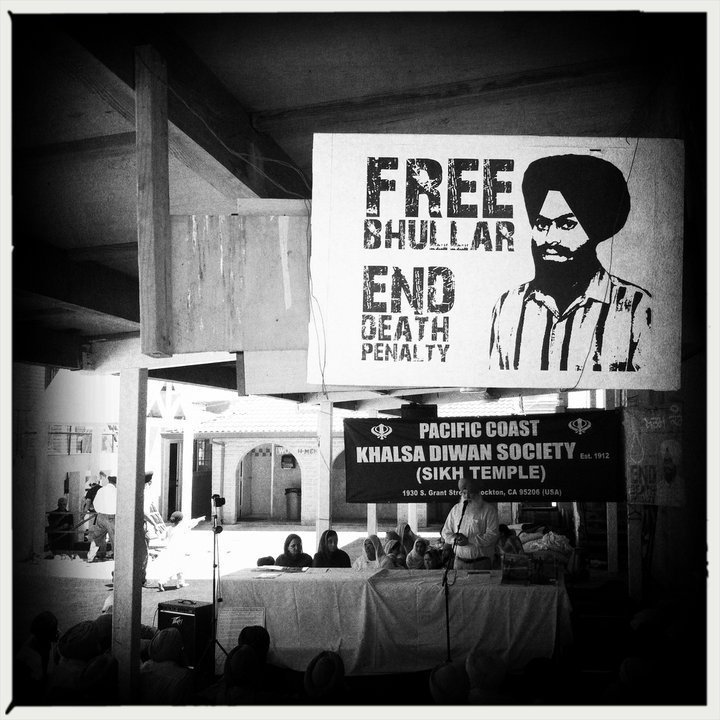 This post has been long overdue. Pagh salute to @SimNona for pushing me to finalize and publish it.
This post has been long overdue. Pagh salute to @SimNona for pushing me to finalize and publish it.
Larger and larger sections of the Sikh community are becoming familiar with the case. Despite the snide comments of the Indian media, even they have caught wind to the increasing T-shirts being seen far and wide, throughout Punjab. The Canadian youth, with the Sikh Activist Network at the forefront, have expressed their concern. The Sikh Federation has pushed for resolutions in the European Parliament and statements of concern by UK Parliamentarians. Amnesty International has weighed in with its opinion. This past weekend the mother of the discussed pleaded the case at the historic Stockton Gurdwara.
What am I talking about? The case of Professor Devender Pal Singh (Davinderpal Singh Bhullar).
A Pakistani friend of mine from Lahore passed on a video about a 70 year old man named Mushtaq Ahmed from a Punjabi village near Gujranwala, who just complete his MPhil and will be starting his PhD soon in Education.
With five daughters and three sons, Mushtaq Ahmed completes all his necessary farm work, including working in the field and managing and livestock, while carrying his books with him. His plans are ambitious: to go to the university and teach, because for him, ‘Being a Muslim, we should get education from cradle to grave.’
Here’s the clip:

I couldn’t help think about how this applies to our community. My intention here is not to distinguish from people who are ‘parrd’ or ‘unparrd’ or the class implications this has in the Sikh community in Punjab and the Diaspora. (I’ve met many unparrd/’uneducated’ people who were far wiser than those who were parrd/‘educated’ in some of the most expensive universities in the Diaspora and in the watan. I don’t like those terms myself but just laying out what’s what.) From a Sikh point of view this type of distinction is quite counter productive and has nothing to do with living a life that is Guru-centered.
Really I don’t. Although independent bookstores are often preferable (I swear I am not a hipster), sometimes even Barnes and Noble (see a hipster would never go there!) or Borders (are they even in business?) will do.
Since I was a kid though, I would always look for books that might have anything remotely to do with Sikhi. The closest we get in our American bookstores are some comprehensive book on religion, usually in the bargain section, and written by some crackpot. This one is presented to you by a professor at Cambridge (@blighty, where you at?)
Oh the bane of my childhood. Then as in now – this is what we get.
Here is the cover….
 Ok, fair enough, nothing really wrong about that. So now let us flip the the chapter on Sikhi. Let’s see what we find….
Ok, fair enough, nothing really wrong about that. So now let us flip the the chapter on Sikhi. Let’s see what we find….
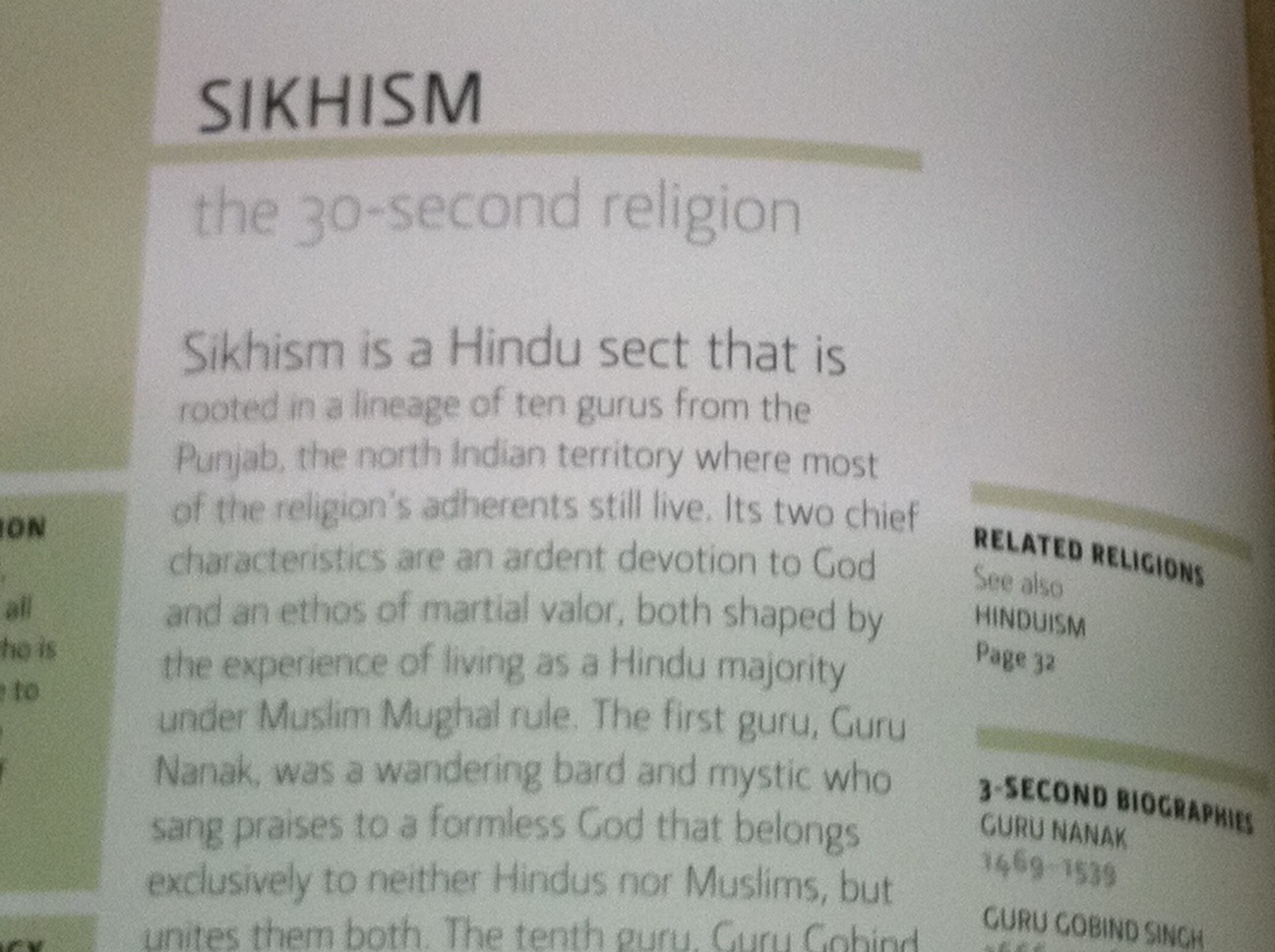
Aaaaaaaaaaaaaand there we go….first sentence! When can we move beyond this? The community has. When will academics and other popular writers move beyond this disinformation that later does get parroted by young Sikhs. Suggestions?
For those interested. The professor’s email address can be found here and his facebook page here. Maybe we can message him? DO IT RESPECTFULLY!!!!!! WE ARE JUST INFORMING, NOT ACCUSING!
 So for this post, I again turn towards Canada, but this time focusing on football (sorry Blighty – let me translate for you – “badibididongbong” or “makubadabuda”, lol).
So for this post, I again turn towards Canada, but this time focusing on football (sorry Blighty – let me translate for you – “badibididongbong” or “makubadabuda”, lol).
Back in the day I wrote a post on this budding football player and since that time many thought he dropped off the map. Despite the lapse in time, this now 28 year old, Singh is still trying to fulfill his football dreams.
At 28, most players who have yet to make an impact would have gone on to the next phase of their life. Bassi says he cannot yet because his football career, in a sense, has yet to start.[link]
Now on the practice team of the B.C. Lions, Bassi is still striving for his opportunity. Despite a career that has been so-far plagued by injury, this Singh remains in chardikala (eternal optimism!)
“That’s why I never gave up,” he said after his first formal workout with the Lions after six seasons Monday. “This is a new time in my life and I have an amazing opportunity.”[link]
Whatever the outcome the Sikh community will still continue to root for him.
Let’s see how this one goes….
Now first off, I love the Sikh Activist Network. On the cutting edge of engagement, culture, and arts, they are one of the most fascinating, experimental, and exciting Sikh organizations. Driven by the youth, they have created venues, places for conversation, and new levels of engagement that have energized the Sikh youth, throughout Canada (especially in the GTA), and have inspired many of us in the US, UK, and beyond. They were part of the leaders in the protests against Kamal Nath, increasing the awareness of the case of Prof. Bhullar, in the push towards the genocide recognition in the Canadian Parliament, and even in exposing politicians that do not serve the community.
So my criticism here is not about the organization or even one of the most exciting events in the diaspora – When Lions Roar. These have been featured in The Langar Hall over the years and have generated plenty of praise and enthusiasm. This year’s third annual WLR was an absolute success, with nearly 4000 attendees. You can read about it at our sister blog – Kaurista.
My focus for this post is much more limited. It is on the promo. It is for this reason that I waited well until the program was over to write this post. In some ways the promo provides a springboard for a conversation and a framework for tackling it that is often used in the community, so in that way it is much bigger than the promo. Before reading the rest, watch it here and then continue below the fold.

Guest blogged by Pataka
 The intersections between Sikhism, gender issues, and academia have always been tenuous and fragile ones. As other posts on this blog have mentioned, there have been some recent pushes to democratize academic research as well as examine and undo the longstanding patriarchy which has surrounded academia in general by including discussions of gender politics as well as Sikh women scholars. For more information on SAFAR take a look at previous posts on this issue or visit their website: www.sikhfeministresearch.org .
The intersections between Sikhism, gender issues, and academia have always been tenuous and fragile ones. As other posts on this blog have mentioned, there have been some recent pushes to democratize academic research as well as examine and undo the longstanding patriarchy which has surrounded academia in general by including discussions of gender politics as well as Sikh women scholars. For more information on SAFAR take a look at previous posts on this issue or visit their website: www.sikhfeministresearch.org .
Our Journeys Conference 2011
On October 1st, 2011, SAFAR –The Sikh Feminist Research Institute will host a one-day conference entitled Our Journeys Conference 2011 at The Centre for Women’s Studies in Education (CWSE), Ontario Institute for Studies in Education of the University of Toronto (OISE), University of Toronto, Ontario, Canada.
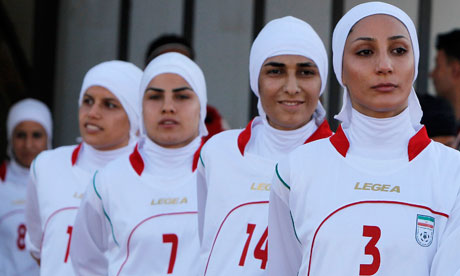
[Note] There has been an update to this post, please see below.
Earlier this month the ruling body for international soccer, FIFA, banned the Iranian women’s team from playing because of their uniforms. The stated reason for the disqualification is that the women’s uniforms, which include a track suit and a head scarf, violated the FIFA dress code. The rules for the 2012 Olympics, according to FIFA, state that,
“[p]layers and officials shall not display political, religious, commercial or personal messages or slogans in any language or form on their playing or team kits.”
Covering the full body is required of women in Iran and when these players were faced with a decision between their faith or football, they chose their faith. Previously, we’ve blogged about the slippery slope of religious symbols, particularly in places like France. Several blogs and opinion pieces have noted that “it seems unlikely that FIFA’s decision is truly independent of any kind of paternalistic or anti-Islamic sentiment, like the anti-head scarf fervor and bigotry going on in France.”
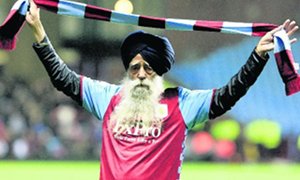 Do Sikhs need to be worried about such policies? Would we need to choose between Sikhi or Soccer? While it seems like this may not be of immediate concern to the Sikh community (because really do YOU know any Sikh
Do Sikhs need to be worried about such policies? Would we need to choose between Sikhi or Soccer? While it seems like this may not be of immediate concern to the Sikh community (because really do YOU know any Sikh football soccer players?!) – it is of concern to us because often times turbans come under similar scrutiny. We have amazing athletes, such as Fauja Singh, who are integrally involved in sports in places like England (there are even Facebook pages dedicated to “Fauja Singh for London 2012 Olympic Torchbearer”). Imagine if this sentiment continues to grow across Europe, as it seems like it is, what will that mean for Fauja Singh and other athletes who wear turbans? So, readers, I’m curious – do we need to worry about this issue?
UPDATE: According to a recent article, Sikhs are impacted by these policies,
Muslims are not the only minorities being affected by the rules of professional sporting bodies, such as FIFA, and those enforcing them. Another player, this time a young Sikh, 14-year-old Sagerpreet Singh, was also prevented from playing because he wears a turban, which the Quebec Soccer Federation argues gives him an “unfair competitive advantage on headers”. Given that turbans do not cover the forehead (the part used for “heading” a ball) it is not clear how this could give an edge to a player.
If you’d like to sign a petition which urges FIFA to reconsider and reevaluate its stance on the dress code restrictions it has placed so that all women can play, you can do so here.
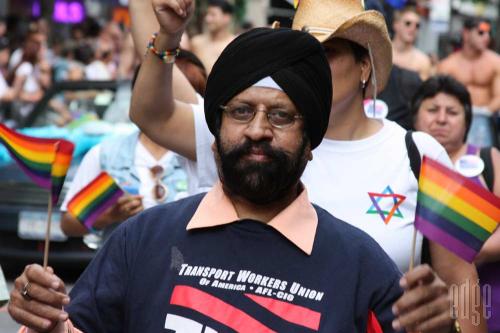
A friend sent me this photo yesterday from this past weekend’s annual LGBT Pride Parade in New York City, which was attended by about a million people. I’ve seen this Singh around NYC before. He happens to be one of the transit workers standing up to the NYC Transit Authority’s discriminatory “turban-branding” policy and now is also standing up for LGBT rights. Sikh solidarity seems to be in full swing lately.
The Pride festivities in NYC were a little different this year since they came just after state lawmakers voted in favor of legalizing gay marriage in New York last week. While some Sikhs (and Sikh institutions) have been outspoken about their opposition to allowing same-sex couples to marry, many others of us are celebrating this milestone civil rights victory in New York, seeing the fight for justice for LGBT people as no different as justice for women, people of color, or any other oppressed group.
Despite my previously alluded to reservations about the state sanctioning the way we structure our romantic relationships, households, and/or families, I believe that legalizing gay marriage is nevertheless a much needed blow to the deeply ingrained homophobia and heterosexism in our society. A lot more than marriage equality is needed to create the sort of radical transformation our Gurus envisioned for our world, but it is, at least today, a reason to say fateh!
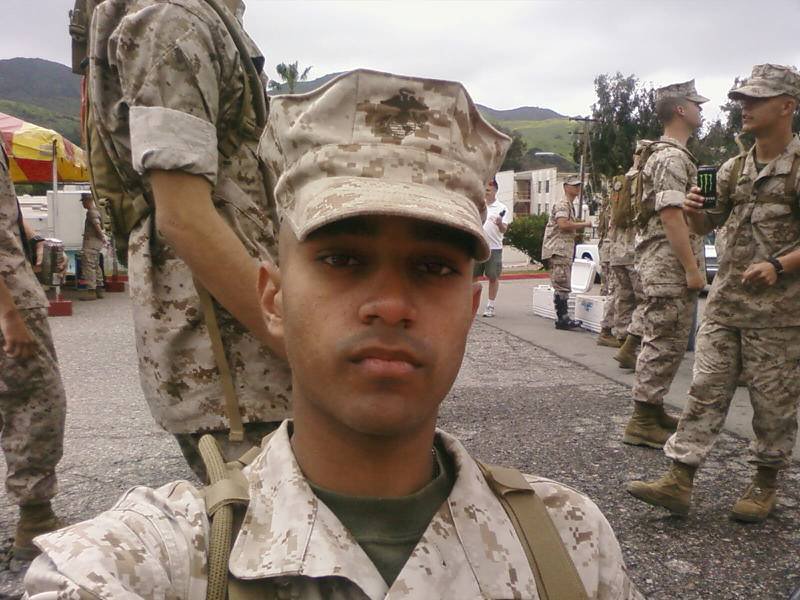 Writing a post such as this can be difficult. A war has gone on for far too long. I do not believe there can be an end-game, other than the action that President Obama is beginning to take. American soldiers must leave Afghanistan. This post is about one that did not.
Writing a post such as this can be difficult. A war has gone on for far too long. I do not believe there can be an end-game, other than the action that President Obama is beginning to take. American soldiers must leave Afghanistan. This post is about one that did not.
I don’t know much about Cpl. Gurpreet Singh. The Sacramento Bee provides a few brief notes about his military career:
A Marine from the Sacramento area has died in combat while fighting in Afghanistan.
Cpl. Gurpreet Singh, 21, of Antelope, died June 22 from wounds suffered in combat operations in Helmand province, the Department of Defense announced today.
Singh, an infantryman, was assigned to 1st Battalion, 5th Marine Regiment, 1st Marine Division, Camp Pendleton.
The Marines said Singh enlisted on Nov. 5, 2007. He served two combat deployments.
His service awards include the Purple Heart, Combat Action Ribbon, National Defense Service Medal, Global War on Terrorism Medal, Marine Corps Good Conduct Medal and Afghanistan Campaign Medal.
“The Marines and sailors of the 1st Marine Division mourn the loss of Cpl. Singh,” stated a Camp Pendleton press release. “Our heartfelt condolences go out to his family.” [link]
I spent the night trying to read and learn about one of our fallen brothers. What was he like? What were his dreams? I learned he was an only son. I learned Gopi loved the Marines. I learned that he loved his family.
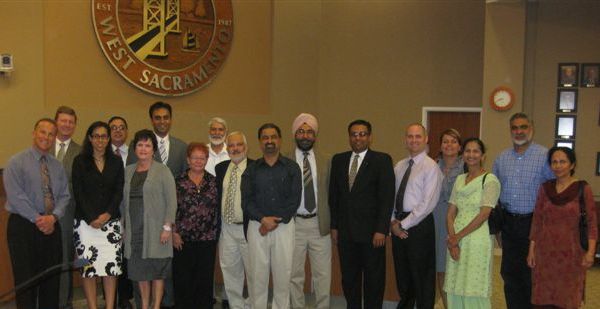 How would you answer this question?
How would you answer this question?
At least for the first time in the US, parents will now have the option. Although billed as a “Punjabi” school, the Sikh sangat in Sacramento [The Sikh community of Sacramento seems to find itself in the limelight quite a bit recently] seems ecstatic that a long time dream in the community can now become a reality. The Sacramento Bee reports:
West Sacramento will be home to the first public Punjabi charter school in the country this fall.
Approved by the Washington Unified School District board this month, the Sacramento Valley Charter School will teach the language and culture of Punjab, a region in northern India and Pakistan.
The publicly funded school will be independently operated by a newly created Punjabi nonprofit. Serving kindergarten through sixth grades, the nonsectarian charter school will be located on a property owned by and next door to the Sikh Temple of Sacramento in West Sacramento. [link]
Although the organizers of the school will be quick (and correctly so) to state that it is NOT a Sikh school and is rather a “non-sectarian” Punjabi school, but with such an intimate relationship with the Gurdwara (at least geographically) and by judging from some of the names of the staff, it does seem clear that it is a “Sikh” (to use the term culturally) school and not what have been called “Khalsa Schools”. Ok enough of the semantics and on to my questions.
Guest-blogged by Mewa Singh. Mewa Singh is a sevadar with the Jakara Movement.
Previously, here in The Langar Hall, there was a discussion by Navdeep Singh on an important panel discussion, held in NYC, on faith, feminism, and Sikhi. Brooklynwala had asked for a comment and report about Lalkaar 2011, and I am more than happy to oblige.
However, before getting into that, I wanted to strongly encourage our Sikh youth sangat throughout California to come to Fresno/Kerman this coming weekend for an amazing opportunity. While most Sikh organizations depend on large contributions by high-fly financiers with their own set of pre-conditions, Sikh youth organizations such as the Jakara Movement and the Sikh Activist Network do not. The Jakara Movement’s biggest donors are its own members, making small contributions and the sweat and blood of its own members that come every year to sell fireworks. This is truly grassroots, where the youth give their own labor for causes and projects they love. Check out the video, follow the facebook event page to sign up, and then click below the fold for my report on Lalkaar 20111.
 Toronto is abuzz. This weekend the IIFA [International Indian Film Academy] awards are being held in Toronto to many a South Asian’s delight. We are, however, delighted about Toronto for another reason. This weekend, The Sikh Activist Network will be hosting When Lions Roar 3 – a night of hip hop, poetry, R&B and other art to remember the events of 1984.
Toronto is abuzz. This weekend the IIFA [International Indian Film Academy] awards are being held in Toronto to many a South Asian’s delight. We are, however, delighted about Toronto for another reason. This weekend, The Sikh Activist Network will be hosting When Lions Roar 3 – a night of hip hop, poetry, R&B and other art to remember the events of 1984.
There is much that can be said about the comparisons between the two events. The IIFA essentially celebrates bollywood – an industry that frustrates many conscious Sikhs living in both India and the diaspora. The representation of Sikhs in bollywood films has been an area of discontent with Punjabis and Sikhs being portrayed as hypermasculine and other cringe-worthy stereotypical roles [read Navdeep’s piece, Media and the Sikhs]. While many applaud the increased presence of Sikh turbans in bollywood films, others may argue that this presence has not necessarily changed the typical Indian’s perception of Sikhs in a positive way. For example, in Indian media – Sikhs continue to be portrayed with words such as terrorist, extremist and radical [read this inaccurate and uninformed article]. I’m not anti-bollywood by any means – there are definite exceptions to the bollywood trend of representing Sikhs in a one-dimensional manner. However, I think it’s important that as a community, we stay informed and expect authentic representation of Sikhs (whether in books or films or other art forms). Bollywood is a huge industry that has an enormous influence on building or breaking down perceptions of groups and communities. [Side note: it’s interesting to me that discussions about Sikhs in bollywood never revolve around Punjabi or Sikh women. This may be a good or bad thing, but perhaps it’s a discussion for another time].
It is clear that the Sikh community cannot rely upon an industry to change overnight – instead, we should focus on supporting and celebrating the immense diversity that makes up our community.

